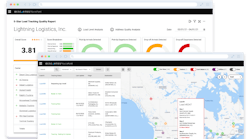A couple of years ago, I was involved in a hearing conducted by the Occupational Safety and Health Administration (OSHA) pertaining to a fatality related to tire and wheel service. The deceased was an experienced tire technician who, for some unknown reason, attempted to correct the seating of multi-piece rim components while the tire was still inflated. His actions were in violation of OSHA regulations—and it cost him his life.
Most of the Secretary of Labor’s case was based on the premise that the employee did not understand the concept of “trajectory.” According to the OSHA definition, trajectory is “any path or route that a rim wheel component may travel during an explosive separation, or the sudden release of the pressurized air, or an area at which an air blast from a single piece rim wheel may be released.” In this instance, we were able to prove through detailed training records that the deceased did understand trajectory, so most of the violations and fines were vacated. But that doesn’t bring him back.
Understanding the risks related to truck tire and wheel service is crucial for anyone who handles or services the assembly. Just a few days before writing this column, I was made aware of another technician (this time fleet maintenance) who was critically injured by a tubeless radial truck tire that experienced a “zipper” rupture. This happened while the technician was inflating the tire on the truck. The blast of pressurized air was so massive that the technician’s injuries required that he be admitted to intensive care. He will be incredibly lucky if he recovers without any long-term disabilities.
Hundreds of thousands of truck drivers and maintenance technicians engage in the practice of inflating truck tires every day. In most instances, they are just “topping them off” by adding a few pounds of pressure. As long as the existing pressure in the tire is above 80% of the recommended inflation, there shouldn’t be any major concerns; however, if the existing pressure is less than 80% of the recommended inflation, the risk of a zipper rupture is increased.
On the other hand, when tires are operated underinflated for extended periods of time, the over-flexing of the sidewall results in steel cord fatigue. If the damage to these body cords reaches a certain point, they are no longer capable of containing the pressurized air inside the tire. The sidewall experiences a circumferential break that resembles a zipper, hence the name zipper rupture.
Technicians or drivers who use OSHA-compliant inflation devices and remain outside the trajectory area are at minimal risk; however, if the employee is positioned in the trajectory zone during inflation, the consequences are severe if the rim separates or the tire experiences a zipper rupture. The most unfortunate fact is that many employees are forced into the trajectory because they don’t have a clip-on air chuck or an extension hose that is long enough to keep them safe.
Recognizing the hazard is only half the battle. Employees need to know what to look for and what to listen for because the bulges in the sidewall and popping sounds are clear signs of a zipper rupture. The other half of the battle is to use the proper equipment and stand even with the tread where the rim components or blast of air do not pose a risk. I’ve been telling students for decades that if you can read the sidewall of the tire during inflation, then you are placing yourself in the trajectory.
It’s such a simple concept that no one should ever be injured. Yet, it continues to happen because people either ignore the rules or fail to pay attention.
Kevin Rohlwing can be reached at [email protected]


